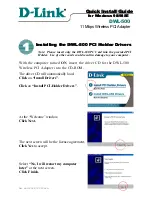
KPCI-3101 — KPCI-3104 Series User’s Manual
The KPCI-3101–4 Series boards are calibrated at the factory and should not require calibration
for initial use. It is recommended that you check and, if necessary, readjust the calibration of the
analog I/O circuitry on the KPCI-3101–4 Series boards every six months.
NOTE
Ensure that you installed the DriverLINX software prior to using the
DriverLINX KPCI-3101–4 Series Calibration Utility. Refer to the
DriverLINX Online Documentation for more information.
This section describes how to run the KPCI-3101–4 Series DriverLINX Calibration Utility and
calibrate the analog I/O circuitry of the KPCI-3101–4 Series boards.
Introduction
Your KPCI-3101–4 Series board was initially calibrated at the factory. You are advised to check
the calibration of a board every six months and to calibrate again when necessary. This section
provides the information you need to calibrate a KPCI-3101–4 Series board.
Objectives
For analog inputs, the objective of this procedure is to zero the offsets and adjust the combined
gain of the A/D converter and instrumentation amplifier. For analog outputs, the objective is to
independently zero the offset and adjust the gain for each of the digital-to-analog converters
(DACs) on your KPCI-3101–4 Series board.
Calibration summary
Analog inputs and outputs are calibrated using a DC calibrator, a DVM/DMM, and the Driver-
LINX Calibration Utility. (The DriverLINX Calibration Utility was installed on your computer
when you installed the DriverLINX software.) No calibration potentiometers must be adjusted.
Instead, on-board trimming digital-to-analog converters (trim DACs) are adjusted digitally
through the Calibration Utility software. No test points on the board are used. Only connections
to the I/O connector pins, via a screw terminal accessory, are needed.
Each of the twelve unipolar and twelve bipolar analog input ranges is individually calibrated.
For each range, three eight-bit trim-DAC values are searched for and then adjusted: a gain value,
a coarse-offset value, and a fine-offset value. Therefore, a complete analog input calibration
involves 72 adjustments: 2 polarities
×
12 gains/polarity
×
3 adjustments/gain.
Equipment
The following equipment is needed to calibrate your KPCI-3101–4 Series board:
•
A digital voltmeter (DVM) or digital multimeter (DMM) accurate to
-⁄
digits, such as a
Keithley Model 2000.
•
An STA-300 screw terminal accessory to make analog connections to the board.
•
A Keithley CAB-305 cable to connect the screw terminal accessory to the I/O connector of
the KPCI-3101–4 board.
•
A DC calibrator or precisely adjustable and metered power supply having up to a 10VDC
range and accurate to 6
½
digits.
Summary of Contents for KPCI-3101 Series
Page 10: ...iv...
Page 15: ...1 Overview...
Page 21: ...2 Principles of Operation...
Page 53: ...3 Installation and Configuration...
Page 78: ...3 26 Installation and Configuration KPCI 3101 KPCI 3104 Series User s Manual...
Page 79: ...4 Testing the Board...
Page 82: ...4 4 Testing the Board KPCI 3101 KPCI 3104 Series User s Manual...
Page 83: ...5 Calibration...
Page 86: ...5 4 Calibration KPCI 3101 KPCI 3104 Series User s Manual...
Page 87: ...6 Troubleshooting...
Page 94: ...6 8 Troubleshooting KPCI 3101 KPCI 3104 Series User s Manual...
Page 95: ...A Specifications...
Page 107: ...B Connector Pin Assignments...
Page 111: ...C Systematic Problem Isolation...
Page 145: ...This page intentionally left blank...
Page 146: ...Keithley Instruments Inc 28775 Aurora Road Cleveland Ohio 44139 Printed in the U S A...
















































